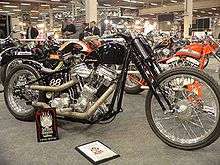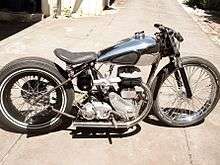Bobber (motorcycle)
A bobber, originally called a 'bob-job' from the 1930s through 1990s, is a style of custom motorcycle. The typical construction includes stripping excess bodywork from a motorcycle; removing the front fender, and shortening the rear fender, which is "bobbed" (as in bob-tail), and all superfluous parts removed to reduce weight.[1][2]


History
The bob-job evolved from an earlier type of American custom motorcycle, the 'Cut Down', which appeared in the late 1920s, and which was based on the Harley-Davidson 'J' series v-twin. The cut-down was created to modernize the appearance and improve the performance of the aging J-series Harley-Davidson. By removing the front fender, shortening the rear, and removing all excess accessories, the motorcycle was significantly lightened. The cut-down was also characterized by a modified frame, in which the seat tube was lowered and the wheelbase shortened, resulting in a lower, shorter machine, with a sweeping diagonal line between the steering head and rear axle.
In 1933 the AMA introduced Class C racing, which stipulated only catalogued racing motorcycles could be used in sanctioned competition, with points gained towards the National Championship. Class C racers such as the Indian Daytona Scout [3] and Harley-Davidson WLDR and WR [4] were the inspiration of the 'bob-job'; these stripped-down racers had no front fender, an abbreviated rear, and no excess weight. Road riders directly copied the look of the racers for better performance and a measure of style. The first bob-jobs appeared in the mid-1930s, and tended to reflect their somber competition origins, with plain paint jobs and no extra chrome or decoration.
Immediately after World War II, bob-jobs, in parallel with hot rods, were subject to increasingly decorative modifications, including extra chrome plating, metal flake paint jobs, pin striping, and colored upholstery. As early as 1946, Kenneth Howard ('Von Dutch') began modifying his Indian Scout bob-job with wild paint jobs, a smaller gas tank, raised handlebars, and exhaust pipes which turned upwards at the rear.[5] Such modifications became the standard for bob-jobs, which grew in popularity, whether as show bikes [6] or ordinary road bikes. The bob-job evolved through the 1950s and 60s in several directions; some were strictly for the popular motorcycle and hot rod show circuit, some had a distinctive 'club bike' style, some reflected drag racing practice, and some were simply a continuation of the original Class C inspiration.
Bob-jobs reflected the aesthetic tastes of their owners, and were home-built, there being no commercially produced road-going bob-job available until the late 1990s.[7] The style has also influenced motorcycle manufacturers, such as Harley-Davidson[8][9] and Honda.[10]
In the late 1990s, the term bob-job became shortened in popular parlance to 'bobber', and the style saw a resurgence in popularity in the custom motorcycle scene. The bobber continues to be favored today; although hybrid styles have emerged, such as the "bobber chopper", and "retro-bobber".[11] Such bobbers exemplify the continuing evolution of the style, and its enduring popularity.[12]
Bobbers vs. choppers
The term 'chopper' did not appear in print until the mid-1960s, over 30 years after the bob-job was invented. The chopper is a more stylistically and technically extreme evolution of the bob-job, which emerged after the highly elaborate, heavily chromed bob-jobs which appeared in the late 1940s and 1950s. Bobbers are typically built around unmodified frames, while choppers use either highly modified or custom-made frames.[13] Chopper frames are often cut and welded into shape. Thus, bobbers are fairly easy to create from stock motorcycles and are generally hand built.
While customized motorcycles can be expensive, bobber builders tend to adopt an economical approach involving old, second-hand, recycled parts and hand-machined items reminiscent of the period before the mass-market motorcycle accessory industry had developed.[11][14]
See also
References
- ↑ Drate, Spencer; Salavetz, Judith (2006). Art of the Bobber (1st ed.). Minneapolis: Motorbooks. ISBN 9780760325315.
The bobber is, far and away, the coolest style of custom motorcycle on the planet.
- ↑ D'Orleans, Paul (2014). Café racers : Speed, Style, and Ton-Up Culture. Minneapolis, Minnesota: Motorbooks. p. 15. ISBN 9780760345825.
- ↑ 'The Harley-Davidson and Indian Wars', Girdler, 1997, MBI, St. Paul, ISBN 0-7603-0208-1
- ↑ 'Harley Davidson Racing 1934-1986', Girdler, 1987, MBI, St.Paul, ISBN 0-7603-1217-6
- ↑ 'The Art of Von Dutch', Kahan, Nason, Quatrocchi, Smith, 2006, Tornado Design, Los Angeles, ISBN 0-9771118-1-4
- ↑ 'Hop Up', Morton, 2002, MBI, St. Paul, ISBN 0-7603-1073-4
- ↑ Miguel, Jose de (2008). How to Build a Bobber on a Budget (1st ed.). Minneapolis: Motorbooks. ISBN 9780760327852.
- ↑ Holmstrom, Darwin (2002). Harley-Davidson Century (1st ed.). Minneapolis: Motorbooks. ISBN 9780760311554.
- ↑ Ets-Hokin, Gabe (23 January 2008). "2008 1/2 Harley Softail Cross Bones, Buell Ulysses XB12XT - First Look". Cycle World. Bonnier Corp. Retrieved 1 January 2015.
The new bike, styled like a classic post-World War II bobber, has apehangers, a springer front end, a cut-down rear fender, a tractor saddle and tough, aggressive styling. It’s another indication of Harley-Davidson emphasizing its history while at the same time reaching out to new, younger consumers.
- ↑ Edwards, David (July 2001). "The Ten Rest 2001". Cycle World Magazine. New York: Hachette Filipacchi Magazines. 40 (7).
Honda Shadow Spirit 750... A spinoff of the ACE 750 retro-wagon with cut-down fenders, chopped suspension and a shotgun exhaust. Simple, sweet and, at $5999, cheap, just like the bobbers of the Forties and Fifties.
- 1 2 Seate, Mike (2004). Outlaw choppers (1st ed.). Minneapolis: Motorbooks. ISBN 9780760318492.
- ↑ Brown, Roland (15 April 2014). "Sport Bobber: Yamaha XV950". Bike India. Next Gen Publishing Ltd. Retrieved 1 January 2015.
Essentially, the XV is a production bobber: a simple, relatively sporty cruiser, designed to be easily customised using a variety of factory-made accessories.
- ↑ Lane, Billy (2005). Billy Lane's How to Build Old School Choppers, Bobbers and Customs (1st ed.). Minneapolis: Motorbooks. ISBN 9780760321683.
- ↑ Baas, Kevin (2011). How to Build an Old Skool [sic] Bobber. Stillwater, MN: Wolfgang Pub. ISBN 9781935828006.